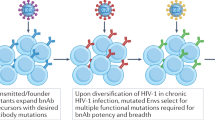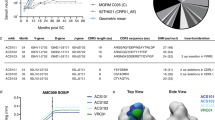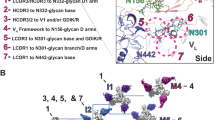Abstract
Neutralizing antibodies are likely to play a crucial part in a preventative HIV-1 vaccine. Although efforts to elicit broadly cross-neutralizing (BCN) antibodies by vaccination have been unsuccessful1,2,3, a minority of individuals naturally develop these antibodies after many years of infection4,5,6,7. How such antibodies arise, and the role of viral evolution in shaping these responses, is unknown. Here we show, in two HIV-1–infected individuals who developed BCN antibodies targeting the glycan at Asn332 on the gp120 envelope, that this glycan was absent on the initial infecting virus. However, this BCN epitope evolved within 6 months, through immune escape from earlier strain-specific antibodies that resulted in a shift of a glycan to position 332. Both viruses that lacked the glycan at amino acid 332 were resistant to the Asn332-dependent BCN monoclonal antibody PGT128 (ref. 8), whereas escaped variants that acquired this glycan were sensitive. Analysis of large sequence and neutralization data sets showed the 332 glycan to be significantly under-represented in transmitted subtype C viruses compared to chronic viruses, with the absence of this glycan corresponding with resistance to PGT128. These findings highlight the dynamic interplay between early antibodies and viral escape in driving the evolution of conserved BCN antibody epitopes.
This is a preview of subscription content, access via your institution
Access options
Subscribe to this journal
Receive 12 print issues and online access
$209.00 per year
only $17.42 per issue
Buy this article
- Purchase on Springer Link
- Instant access to full article PDF
Prices may be subject to local taxes which are calculated during checkout



Similar content being viewed by others
References
Haynes, B.F. & Montefiori, D.C. Aiming to induce broadly reactive neutralizing antibody responses with HIV-1 vaccine candidates. Expert Rev. Vaccines 5, 347–363 (2006).
Hu, S.L. & Stamatatos, L. Prospects of HIV Env modification as an approach to HIV vaccine design. Curr. HIV Res. 5, 507–513 (2007).
Phogat, S. & Wyatt, R. Rational modifications of HIV-1 envelope glycoproteins for immunogen design. Curr. Pharm. Des. 13, 213–227 (2007).
Li, Y. et al. Analysis of neutralization specificities in polyclonal sera derived from human immunodeficiency virus type 1–infected individuals. J. Virol. 83, 1045–1059 (2009).
Sather, D.N. et al. Factors associated with the development of cross-reactive neutralizing antibodies during human immunodeficiency virus type 1 infection. J. Virol. 83, 757–769 (2009).
Simek, M.D. et al. Human immunodeficiency virus type 1 elite neutralizers: individuals with broad and potent neutralizing activity identified by using a high-throughput neutralization assay together with an analytical selection algorithm. J. Virol. 83, 7337–7348 (2009).
Stamatatos, L., Morris, L., Burton, D.R. & Mascola, J.R. Neutralizing antibodies generated during natural HIV-1 infection: good news for an HIV-1 vaccine? Nat. Med. 15, 866–870 (2009).
Walker, L.M. et al. Broad neutralization coverage of HIV by multiple highly potent antibodies. Nature 477, 466–470 (2011).
Richman, D.D., Wrin, T., Little, S.J. & Petropoulos, C.J. Rapid evolution of the neutralizing antibody response to HIV type 1 infection. Proc. Natl. Acad. Sci. USA 100, 4144–4149 (2003).
Wei, X. et al. Antibody neutralization and escape by HIV-1. Nature 422, 307–312 (2003).
Frost, S.D. et al. Neutralizing antibody responses drive the evolution of human immunodeficiency virus type 1 envelope during recent HIV infection. Proc. Natl. Acad. Sci. USA 102, 18514–18519 (2005).
Gray, E.S. et al. Antibody specificities associated with neutralization breadth in plasma from HIV-1 subtype C infected blood donors. J. Virol. 83, 8925–8937 (2009).
Tomaras, G.D. et al. Polyclonal B cell responses to conserved neutralization epitopes in a subset of HIV-1–infected individuals. J. Virol. 85, 11502–11519 (2011).
Walker, L.M. et al. A limited number of antibody specificities mediate broad and potent serum neutralization in selected HIV-1 infected individuals. PLoS Pathog. 6, e1001028 (2010).
Gray, E.S. et al. HIV-1 neutralization breadth develops incrementally over 4 years and is associated with CD4+ T cell decline and high viral load during acute infection. J. Virol. 85, 4828–4840 (2011).
Nandi, A. et al. Epitopes for broad and potent neutralizing antibody responses during chronic infection with human immunodeficiency virus type 1. Virology 396, 339–348 (2010).
Tang, H. et al. epitopes immediately below the base of the V3 loop of gp120 as targets for the initial autologous neutralizing antibody response in two HIV-1 subtype B–infected individuals. J. Virol. 85, 9286–9299 (2011).
Walker, L.M. et al. Broad and potent neutralizing antibodies from an African donor reveal a new HIV-1 vaccine target. Science 326, 285–289 (2009).
Pejchal, R. et al. A potent and broad neutralizing antibody recognizes and penetrates the HIV glycan shield. Science 334, 1097–1103 (2011).
Abrahams, M.R. et al. Quantitating the multiplicity of infection with HIV-1 subtype C reveals a non-Poisson distribution of transmitted variants. J. Virol. 83, 3556–3567 (2009).
Moore, P.L. et al. The C3–V4 region is a major target of autologous neutralizing antibodies in human immunodeficiency virus type 1 subtype C infection. J. Virol. 82, 1860–1869 (2008).
Moore, P.L. et al. Limited neutralizing antibody specificities drive neutralization escape in early HIV-1 subtype C infection. PLoS Pathog. 5, e1000598 (2009).
Gray, E.S., Moore, P.L., Pantophlet, R.A. & Morris, L. N-linked glycan modifications in gp120 of human immunodeficiency virus type 1 subtype C render partial sensitivity to 2G12 antibody neutralization. J. Virol. 81, 10769–10776 (2007).
Binley, J.M. et al. Comprehensive cross-clade neutralization analysis of a panel of anti-human immunodeficiency virus type 1 monoclonal antibodies. J. Virol. 78, 13232–13252 (2004).
Bures, R. et al. Regional clustering of shared neutralization determinants on primary isolates of clade C human immunodeficiency virus type 1 from South Africa. J. Virol. 76, 2233–2244 (2002).
Gray, E.S., Meyers, T., Gray, G., Montefiori, D.C. & Morris, L. Insensitivity of paediatric HIV-1 subtype C viruses to broadly neutralising monoclonal antibodies raised against subtype B. PLoS Med. 3, e255 (2006).
Zhang, M. et al. Tracking global patterns of N-linked glycosylation site variation in highly variable viral glycoproteins: HIV, SIV, and HCV envelopes and influenza hemagglutinin. Glycobiology 14, 1229–1246 (2004).
Gnanakaran, S. et al. Recurrent signature patterns in HIV-1 B clade envelope glycoproteins associated with either early or chronic infections. PLoS Pathog. 7, e1002209 (2011).
Bunnik, E.M. et al. Adaptation of HIV-1 envelope gp120 to humoral immunity at a population level. Nat. Med. 16, 995–997 (2010).
Salazar-Gonzalez, J.F. et al. Deciphering human immunodeficiency virus type 1 transmission and early envelope diversification by single-genome amplification and sequencing. J. Virol. 82, 3952–3970 (2008).
Gorny, M.K. & Zolla-Pazner, S. Immunoprophylaxis against mother-to-child transmission of HIV-1. PLoS Med. 3, e259 (2006).
Walker, L.M. et al. Rapid development of glycan-specific, broad, and potent anti-HIV-1 gp120 neutralizing antibodies in an R5 SIV/HIV chimeric virus infected macaque. Proc. Natl. Acad. Sci. USA 108, 20125–20129 (2011).
van Loggerenberg, F. et al. Establishing a cohort at high risk of HIV infection in South Africa: challenges and experiences of the CAPRISA 002 acute infection study. PLoS ONE 3, e1954 (2008).
Abdool Karim, Q. et al. Effectiveness and safety of tenofovir gel, an antiretroviral microbicide, for the prevention of HIV infection in women. Science 329, 1168–1174 (2010).
Gao, F. et al. Molecular cloning and analysis of functional envelope genes from human immunodeficiency virus type 1 sequence subtypes A through G. The WHO and NIAID Networks for HIV Isolation and Characterization. J. Virol. 70, 1651–1667 (1996).
Gray, E.S. et al. Neutralizing antibody responses in acute human immunodeficiency virus type 1 subtype C infection. J. Virol. 81, 6187–6196 (2007).
Acknowledgements
We thank the participants in the CAPRISA 002 and 004 cohorts and the clinical and laboratory staff at CAPRISA for managing the cohort and providing specimens. 293T cells were obtained from G. Shaw (University of Alabama, Birmingham). We are grateful to D. Burton and W. Koff of the International AIDS Vaccine Initiative for providing the PGT monoclonal antibodies and to S. Gnanakaran (Los Alamos National Laboratories, Los Alamos, New Mexico) for providing transmitted/founder and chronic subtype B sequences. We thank Z. Valley-Omar and N. Ndabambi for generating some envelope sequences. We are grateful to B. Hahn and J. Kim, who contributed transmitted/founder subtype C clones to the Vaccine Immune Monitoring Core Standard Virus Panel Consortium. This work was funded by CAPRISA, the Centre for HIV/AIDS Vaccine Immunology, the South African HIV/AIDS Research and Innovation Platform of the South African Department of Science and Technology and by a US National Institutes of Health grant (number AI088610). CAPRISA was initially supported by the US National Institute of Allergy and Infectious Diseases, US National Institutes of Health, US Department of Health and Human Services grant U19 AI51794. M.S.S. is funded by the Bill & Melinda Gates Foundation, Vaccine Immune Monitoring Consortium of the Collaboration for AIDS Vaccine Discovery (grant 1032144). P.L.M. and E.S.G. were supported by the Columbia University-Southern African Fogarty AIDS International Training and Research Program through the Fogarty International Center, National Institutes of Health (grant 5 D43 TW000231). P.L.M. is a Wellcome Trust Intermediate Fellow in Public Health and Tropical Medicine (grant 089933/Z/09/Z).
Author information
Authors and Affiliations
Contributions
P.L.M. and E.S.G. designed the study, performed experiments, analyzed data and wrote the manuscript; E.S.G., C.K.W., J.N.B., T.H. and N.L.T. performed neutralization experiments and analyzed data; E.S.G., C.K.W., D.J.S., M.N., B.E.L. and N.R. generated single-genome sequences; D.J.S. and N.N. performed part of the sequence analyses; M.-R.A., L.P., R.I.S. and C.W. contributed the subtype C acute and chronic sequences; S.B. and M.S.S. designed and performed the neutralization experiments using the panel of transmitted/founder viruses; S.S.A.K., Q.A.K. and C.W. established the CAPRISA cohorts and contributed samples and data for these subjects; and L.M. designed the study and wrote the manuscript.
Corresponding author
Ethics declarations
Competing interests
The authors declare no competing financial interests.
Supplementary information
Supplementary Text and Figures
Supplementary Figures 1–6 (PDF 1306 kb)
Rights and permissions
About this article
Cite this article
Moore, P., Gray, E., Wibmer, C. et al. Evolution of an HIV glycan–dependent broadly neutralizing antibody epitope through immune escape. Nat Med 18, 1688–1692 (2012). https://doi.org/10.1038/nm.2985
Received:
Accepted:
Published:
Issue Date:
DOI: https://doi.org/10.1038/nm.2985
This article is cited by
-
Dynamics and durability of HIV-1 neutralization are determined by viral replication
Nature Medicine (2023)
-
Dynamics Analysis of a Delayed HIV Infection Model with CTL Immune Response and Antibody Immune Response
Acta Mathematica Scientia (2021)
-
Longitudinal analysis of subtype C envelope tropism for memory CD4+ T cell subsets over the first 3 years of untreated HIV-1 infection
Retrovirology (2020)
-
Broadly neutralizing plasma antibodies effective against autologous circulating viruses in infants with multivariant HIV-1 infection
Nature Communications (2020)
-
Serum alpha-mannosidase as an additional barrier to eliciting oligomannose-specific HIV-1-neutralizing antibodies
Scientific Reports (2020)



